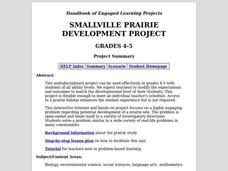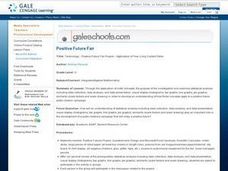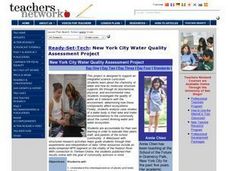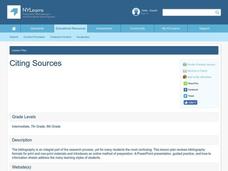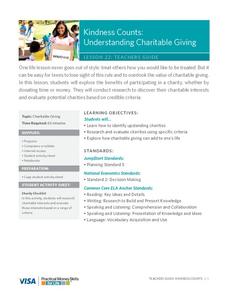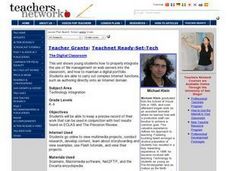Curated OER
Students Exploring Cyberspace (SECs) Project
Students study AIDS and other current topics in a multinational, interdisciplinary fashion. They communicate with students from other countries throughout e-mail to find out how AIDS impacts other societies.
Curated OER
A Multimedia Science Project: Minorities and Women in Science
Eighth graders create a multimedia presenttation written presentation, and oral presentation detailing the contributions of three minority or female scientists throughout history.
Curated OER
Our Country's Landforms
Learners investigate the many different landforms that are found throughout the United States. They use the internet and other resources to gather information. The information is used to prepare a multimedia slideshow and to create a...
Curated OER
Smallville Prairie Development Project
Students, through group activities, explain the important scientific, social/historical and aesthetic values of a prairie habitat. They analyze the impact of humans on prairieland and solve a problem regarding potential development of a...
Alabama Learning Exchange
Planetary Cereal Project
Sixth graders decorate an empty cereal box with information and games showing their comprehension of factual information about an assigned planet. This is a nice, creative lesson about the solar system.
Curated OER
Positive Future Fair Project
Ninth graders view the film "Pay It Forward" and discuss what kind of public campaign is needed to move people to positive action. They consider different ways of presenting information (graphs, visual displays, etc.) as tools for...
Curated OER
Presenting Research with PowerPoint
Students organize information and prepare a visual interpretation that enhances an oral presentation using pictures, graphics and sound.
Curated OER
New York City Water Quality Assessment Project
Young scholars investigate the chemistry of water and how its molecular structure supports life through its biochemcial, physical, and environmental roles. They investigate the quality of water as it interacts with the environment. ...
Curated OER
PERSONA PROJECT
Students examine the role and influence of the major political, literary, and artistic figures in Russian history and in present-day Russia.
Curated OER
Dia de los Muertas/Day of the Dead Cultural Project
Young scholars explore the celebrations of different cultures, comparing and contrasting what is unique to them. Students explore different ways to celebrate those holidays. They construct a personalized alter to demonstrate one aspect...
Curated OER
Cruising the Internet
Students identify the parts of an engine using a graph. In this statistics lesson, students make a graph from their collected data. They calculate the volume of a cylinder using a line of regression and a scatter plot.
Curated OER
A Dollar Goes A Long Way
Investigate life along the Old Spanish Trail! They visit websites and identify the history and environment. They create journals, dramatic enactments, and maps to discover the role individuals played in society. They also explore the...
Social Media Toolbox
Social Media Survey
Survey says ... social media is here to stay! How do the pupils in your school use social media? Using lesson four from a 16-part series, The Social Media Toolbox, learners study surveys and create their own. The resource includes...
Teach Engineering
Where Are the Plastics Near Me? (Mapping the Data)
The last activity in a nine-part series has teams create a Google Earth map using the data they collected during a field trip. Using the map, groups analyze the results and make adjustments to the map to reflect their analysis. A short...
The New York Times
Sequencing the Stages: Understanding H.I.V. Infection at the Molecular Level
How does HIV operate at the molecular level? Pupils discover the progression from a healthy immune cell to one infected with HIV, watch an animation of the HIV life cycle, and finally identify each of the stages with illustrations on...
Curated OER
Citing Sources
Practice citation skills with this activity, which takes learners to the Library/Media center. There, they will view a Powerpoint presentation and practice collecting data in both print and non-print sources. All necessary materials are...
Curated OER
Hurricanes on Track
Fifth graders develop a questionnaire to investigate weather in different part of the US. They investigate how weather in one part of the country affects weather in another part. They predict the development of hurricanes.
Visa
Kindness Counts: Understanding Charitable Giving
Financial literacy is generally focused on personal spending and saving, but consider an opportunity to talk to your pupils about how charitable giving can also factor into money management and how it can enhance life for both oneself...
Curated OER
The Chesapeake Bay in Captain John Smith's Time
When Captain John Smith visited the Chesapeake Bay in the summer of 1608, what types of animals and habitats did he encounter? Your young historians will analyze primary source documents to answer this question, as well as compare the...
NASA
NASA
Everything you have ever wanted to know about our solar system, space exploration, and more can be found here. Be prepared to clear your schedule; you will be sucked into the app like a star into a black hole.
Teach Engineering
Introduction to Water Chemistry
What are the issues surrounding water quality? Viewers of this short presentation gain information about the importance of clean water, the lack of fresh water, water contamination, and ways that engineers treat water.
Curated OER
Technology: The Digital Classroom
Students discover how to integrate file management systems on Web servers into the classroom. In addition to maintaining digital portfolios, they develop various Internet functions such as authoring directly onto an Internet domain.
Curated OER
Creating a Nutrition Table in MicroSoftExcel
Middle schoolers access the internet to find Nutritional information from a restaurant of their choice and compile their information into an excel spreadsheet.
Curated OER
Historical Figures
Student research a "Historical Individual" using the Internet. They print a minimum of five articles and organize them. They create a visual biography of their historical figure.





